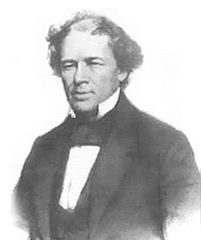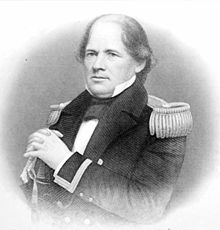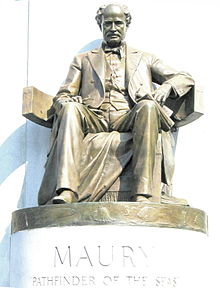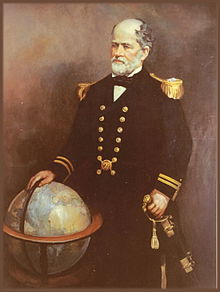- Matthew Fontaine Maury
-
Matthew Fontaine Maury (January 14, 1806 – February 1, 1873), United States Navy was an American astronomer, historian, oceanographer, meteorologist, cartographer, author, geologist, and educator.
He was nicknamed "Pathfinder of the Seas" and "Father of Modern Oceanography and Naval Meteorology" and later, "Scientist of the Seas," due to the publication of his extensive works in his books, especially Physical Geography of the Sea (1855), the first extensive and comprehensive book on oceanography to be published. Maury made many important new contributions to charting winds and ocean currents, including ocean lanes for passing ships at sea.
In 1825 at age 19, Maury joined the United States Navy as a midshipman on board the frigate USS Brandywine. Almost immediately he began to study the seas and record methods of navigation. When a leg injury left him unfit for sea duty, Maury devoted his time to the study of navigation, meteorology, winds, and currents. His hard work on and love of plotting the oceans paid off when he became Superintendent of the U.S. Naval Observatory and head of the Depot of Charts and Instruments. Here, Maury studied thousands of ships' logs and charts. He published the Wind and Current Chart of the North Atlantic, which showed sailors how to use the ocean's currents and winds to their advantage and drastically reduced the length of ocean voyages. Maury's uniform system of recording oceanographic data was adopted by navies and merchant marines around the world and was used to develop charts for all the major trade routes.
With the outbreak of the Civil War, Maury, a Virginian, resigned his commission as a U. S. Navy commander and joined the Confederacy. He spent the war in the South, as well as abroad in Great Britain, acquiring ships for the Confederacy. Following the war, Maury accepted a teaching position at the Virginia Military Institute in Lexington, Virginia. He died at his home in Lexington in 1873 after completing an exhausting national lecture tour.
Contents
Early life and career
Maury was of Huguenot ancestry whose family can be traced back to 15th century France. Matthew Fontaine Maury's grandfather (the Reverend James Maury) was an inspiring teacher to a future U. S. president, Thomas Jefferson. Maury also had Dutch-American ethnicity from the "Minor" family of early Virginia.
M. F. Maury was born in 1806 in Spotsylvania County, Virginia, but his family moved to Franklin, Tennessee when he was five. He wanted to emulate the naval career of his older brother, Flag Lieutenant John Minor Maury, who however caught yellow fever after fighting pirates as an officer in the United States Navy. As a result of John's painful death, Matthew Maury's father, Richard, forbade him from joining the Navy. Maury strongly considered attending West Point to get a better education than the navy could offer at that time, but instead he obtained a Naval appointment through the influence of Senator Sam Houston in 1825, at the age of 19.
Maury joined the Navy as a midshipman on board the frigate Brandywine which was carrying the Marquis de La Fayette home to France. Almost immediately, Maury began to study the seas and record methods of navigation. One of the experiences that piqued this interest was when he circumnavigated the globe on the USS Vincennes, the first US warship to travel around the world.
Matthew Maury's seagoing days came to an abrupt end at the age of 33 after a stagecoach accident broke his hip and knee. Thereafter, he devoted his time to the study of naval meteorology, navigation, charting the winds and currents, seeking the "Paths of the Seas" mentioned in Psalms 8:8 "The fowl of the air, and the fish of the sea, and whatsoever passeth through the paths of the seas." Maury had known of the Psalms of David since childhood. In "A Life of Matthew Fontaine Maury; compiled by his daughter, Diana Fontaine Maury Corbin (1888)" she states on pages 7–8, "Matthew's father was very exact in the religious training of his family, now numbering five sons and four daughters, viz., John Minor, Mary, Walker, Matilda, Betsy, Richard Launcelot, Matthew Fontaine, Catherine, and Charles. He would assemble them night and morning to read the Psalter for the day, verse and verse about; and in this way, so familiar did this barefooted boy [M. F. Maury] become with the Psalms of David, that in after life he could cite a quotation, and give chapter and verse, as if he had the Bible open before him.[1]
His hard work on and love of plotting the oceans paid off when he became the first superintendent of the United States Naval Observatory in 1842, holding that position until his resignation in April 1861. The observatory's primary mission was to care for the United States Navy's marine chronometers, charts, and other navigational equipment. Maury was in fact one of the principle advocates for the founding of a national observatory, and appealed to science enthusiast and U.S. President John Quincy Adams for the creation of what would eventually become the Naval Observatory. Maury did on occasion host Adams, who enjoyed astronomy as an avocation, at the Naval Observatory.
As a sailor, Maury noted that there were numerous lessons that had been learned by ship-masters about the effects of adverse winds and drift currents on the path of a ship. The captains recorded these lessons faithfully in their logbooks, but they were then forgotten. At the Observatory, Maury uncovered an enormous collection of thousands of old ships' logs and charts in storage in trunks dating back to the start of the United States Navy. Maury pored over these documents to collect information on winds, calms, and currents for all seas in all seasons. His dream was to put this information in the hands of all captains.[2]
Maury also used the old ships' logs to chart the migration of whales. Whalers at the time went to sea, sometimes for years, without knowing that whales migrate and that their paths could be charted.
Maury's work on ocean currents led him to advocate his theory of the Northwest Passage, as well as the hypothesis that an area in the ocean near the North Pole is occasionally free of ice. The reasoning behind this was sound. Logs of old whaler ships indicated the designs and markings of harpoons. Harpoons found in captured whales in the Atlantic had been shot by ships in the Pacific and vice versa, and this occurred with a frequency that would have been impossible had the whales traveled around Cape Horn.
Maury, knowing a whale to be a mammal, theorized that a northern passage between the oceans that was free of ice must exist to enable the whales to surface and breathe. This became a popular idea that inspired many explorers to seek a reliably navigable sea route. Many of those explorers died in their search.
Lieutenant Maury published his Wind and Current Chart of the North Atlantic, which showed sailors how to use the ocean's currents and winds to their advantage and drastically reduced the length of ocean voyages; his Sailing Directions and Physical Geography of the Seas and Its Meteorology remain standard. Maury's uniform system of recording synoptic oceanographic data was adopted by navies and merchant marines around the world and was used to develop charts for all the major trade routes.
Maury's Observatory team included James Melville Gilliss, Lieutenant John Mercer Brooke, William Lewis Herndon, Lieutenant Isaac Strain, John Minor Maury of the U.S.N. 1854 Darien Exploration Expedition, Lardner Gibbon and others — but their duty was always temporary at the Observatory, and new men had to be trained over and over again. Thus Lt. M F Maury was working with astronomical work and nautical work at the same time, while constantly training new temporary men to assist in these works.
Maury advocated much in the way of naval reform, including a school for the Navy that would rival the army's West Point. This reform was heavily pushed by Maury's many "Scraps from the Lucky Bag" and other articles printed in the newspapers and many changes came about in the navy including his finally fulfilled dream of the creation of the United States Naval Academy.
Maury also advocated an international sea and land weather service. Having charted the seas and currents, he worked on charting land weather forecasting. Congress refused to appropriate funds for a land system of weather observations.
Maury early became convinced that adequate scientific knowledge of the sea could be obtained only through international cooperation. He proposed that the United States invite the maritime nations of the world to a conference to establish a “universal system” of meteorology, and he was the leading spirit of that pioneer scientific conference when it met in Brussels in 1853. Within a few years, nations owning three fourths of the shipping of the world were sending their oceanographic observations to Maury at the Naval Observatory, where the information was evaluated and the results given worldwide distribution.[3]
Maury was sent by the United States as advocator of his sea data collecting ideas but not for land. Still, as a result of the Brussels conference a large number of nations, including many traditional enemies, agreed to cooperate in the sharing of land and sea weather data using uniform standards.[2]
It was soon after the Brussels conference when Prussia, Spain, Sardinia, the free city of Hamburg, the republic of Bremen, Chile, Austria, and Brazil, and others all joined the enterprise.
The Pope established honorary flags of distinction for the ships of the papal states, which could be awarded only to those vessels which filled out and sent to Maury in Washington D.C. the Maury abstract logs.[4]
In the early 1850s Matthew Fontaine Maury had planned and did send by 1851, his cousin, William Lewis Herndon, and another co-worker at the Naval Observatory, Lardner Gibbon, both of whom worked at the USN Observatory, to explore the Valley of the Amazon region to Brazil and the Atlantic Ocean, while gathering as much information as possible for trade and slavery in any of those areas. In addition, Maury thought the area could serve as a "safety valve" by allowing Southern slave owners to move there or sell their slaves there. He reasoned that Brazil was bringing in new slaves from Africa and by moving those who were already slaves in the United States to Brazil, there would be less slavery or in time perhaps no slavery in as many areas of the United States as possible while also cutting down on bringing new slaves into Brazil which only increased slavery through the capture and enslavement in Brazil of more Africans. "Imagine", Maury wrote to his cousin, "waking up some day and finding our country free of slavery!"[1]
In 1849, Maury spoke out on the need for a transcontinental railroad to join the eastern United States to California. He recommended a southerly route with Memphis, Tennessee as the eastern terminus, since the city is equidistant from Lake Michigan and the Gulf of Mexico. He argued that a southerly route running through Texas would avoid winter snows and could open up commerce with the northern states of Mexico. Maury also advocated construction of a railroad across the Isthmus of Panama.[5]
Civil War
With the outbreak of the American Civil War, Maury, a native of Virginia, ended the career that he dearly loved by handing in his commission as a U.S. Navy Commander in order to serve Virginia, which had joined the Confederacy, as Chief of Sea Coast, River and Harbor Defences. Because he was an international figure, he was ordered to go abroad for many reasons including propaganda for the Confederacy, for peace, and for purchasing ships. He also went to England, Ireland, and France, acquiring ships and supplies for the Confederacy. Through speeches and newspaper publications, Maury tried desperately to get other nations to stop the American Civil War, carrying pleas for peace in one hand and a sword in the other, each to deal with whatever the outcome.
Maury also perfected an electric torpedo which raised havoc with northern shipping. Maury had experience with the transatlantic cable and electricity flowing through wires underwater when working with Cyrus West Field and Samuel Finley Breese Morse. The torpedoes, similar to present-day contact mines, were said by the Secretary of the Navy in 1865 "to have cost the Union more vessels than all other causes combined."[2]
The war brought ruin to many in Fredericksburg, Virginia, where Maury's immediate family lived. Following the war, after serving Maximilian in Mexico as "Imperial Commissioner of Immigration" and building Carlotta and New Virginia Colony for displaced Confederates and immigrants from other lands, Maury accepted a teaching position at the Virginia Military Institute (VMI), holding the chair of physics.
Maury advocated the creation of an agricultural college to complement VMI. This led to the establishment of the Virginia Agricultural and Mechanical College (Virginia Tech) in Blacksburg, Virginia in 1872.[6] Maury declined the offer to become its first president partly because of his age. He had previously been suggested as president of the College of William and Mary in Williamsburg, Virginia in 1848 by Benjamin Blake Minor in his publication the Southern Literary Messenger. Maury considered becoming president of St. John's College in Annapolis Maryland, the University of Alabama, and the University of Tennessee.[7] It appears that he preferred being close to General Robert E. Lee in Lexington from statements Maury made in letters. Maury served as a pall bearer for General Lee.[8]
During his time at VMI, Maury wrote a book entitled The Physical Geography of Virginia. He had once been a gold mining superintendent outside of Fredericksburg, Virginia, and had studied geology intensely during that time, so was well equipped to write such a book. During the Civil War, more battles took place in Virginia than any other state (Tennessee was second), and Maury's aim was to assist war-torn Virginia in discovering and extracting minerals, improving farming and whatever else could assist her to rebuild after such destruction.
During its first 1848 meeting, Maury helped launch the American Association for the Advancement of Science (AAAS).
Maury later gave talks in Europe about cooperation on a weather bureau for land just as he had charted the winds and predicted storms at sea many years before. He gave these Weather on Land speeches until his last days when he collapsed giving a speech. He went home after he recovered and told Ann Hull Herndon-Maury, his wife, "I have come home to die."
Matthew Fontaine Maury died at home in Lexington. He was exhausted from traveling throughout this nation while giving speeches promoting Land Meteorology. Maury breathed his last breath at 12:40 P.M., on Saturday, February 1, 1873. He was attended by his eldest son, Major Richard Launcelot Maury and son-in- law, Major Spottswood Wellford Corbin. Maury asked his daughters and wife to leave the room. His last words were, "All's well", a nautical expression telling of calm conditions at sea, as he raised his hands into the air as though being taken to a better place.[1] His body was placed on display in the VMI library. Maury was initially buried in the Gilham family vault in Lexington's cemetery, across from Thomas "Stonewall" Jackson, until, after some delay into the next year, when his remains were taken through Goshen Pass to Richmond, Virginia. He was reburied between Presidents James Monroe and John Tyler in Hollywood Cemetery in Richmond, Virginia.
International honors
Bust of Maury in the Hall of Fame for Great Americans, New York, NY.
After decades of national and international hard work averaging 14 hours per day, Maury received fame and honors, including being knighted by several nations and given medals with precious gems, as well as a collection of all medals struck by Pope Pius IX during his pontificate, a book dedication and more from Father Angelo Secchi, who was a student of Maury from 1848 – 1849 in the U.S. Naval Observatory. The two remained life-long friends. Other religious friends of Maury included James Hervey Otey, M. F. Maury's former teacher who, before 1857, worked with Bishop Leonidas Polk on the construction of the University of the South in Tennessee. While visiting there, Maury was convinced by his old teacher to give the "cornerstone speech".
As a United States Navy officer, he declined awards from foreign nations as their acceptance was against U.S. military policy. However, they were offered to Commander Matthew Fontaine Maury's wife, Ann Hull Herndon-Maury, who accepted them for her husband. Some have been placed at Virginia Military Institute, others were loaned to the Smithsonian and yet others remain in the family. Matthew Maury became a Commodore (often a title of courtesy) in the Virginia Provisional Navy, and a Commander in the Confederacy.
A monument to Maury, by sculptor Frederick William Sievers, was unveiled in Richmond on November 11, 1929. Maury Hall, the home of the Naval Science Department at the University of Virginia and headquarters of the University's Navy ROTC battalion, was named in his honor. The original building of the College of William & Mary Virginia Institute of Marine Science is named Maury Hall as well. Another Maury Hall, named after him, houses the Electrical and Computer Engineering Department and the Systems Engineering Department at the United States Naval Academy in Annapolis, Maryland.
Ships have been named in his honor, including three United States Navy ships named USS Maury. A fourth United States Navy ship named in his honor was the "USS Commodore Maury" (SP-656), patrol vessel and mine sweeper.[9] of World War I. A World War II Liberty Ship was also named in his honor. Additionally, Tidewater Community College, based in Norfolk Virginia, owns the R/V Matthew F. Maury.[10] This ship is used for Oceanography research and student cruises.
Lake Maury in Newport News, Virginia is named after Maury. The Lake is located on the Mariners' Museum property and is encircled by a walking trail. The Maury River, located entirely in Rockbridge County, Virginia, near Virginia Military Institute (where Maury was on faculty), also honors the scientist, as does a Maury (crater) on the Moon.
Additionally, a high school in Norfolk, VA is named for Maury, and has been ranked in the top 1000 high schools in the country, and the highest in the city, by Newsweek. Matthew Fontaine Maury High School is located in Norfolk Public Schools which was named the Best Urban School District last year. Maury County, TN is named for his great-uncle.
Also, Maury Elementary School, in Alexandria, VA was named for Matthew Maury. Maury Elementary was built in 1926.
Dan Graves listed Matthew Maury among his 48 great Scientists of Faith on grounds that: Maury lived by the Scriptures; he fully and unconditionally believed in what the Holy Scriptures stated; he hardly ever spoke or wrote without the inclusion of scriptural references; he prayed every day.
See also
References
- ^ a b c Diana Fontaine Maury-Corbin "Life of Matthew Fontaine Maury USN & CSN" Life of Matthew Fontaine Maury, U.S.N. and C.S.N.
- ^ a b c David L. Cohn Pathfinder of the Seas. The Nautical Gazette, May '40
- ^ Frances L. Williams Matthew Fontaine Maury, Scientist of the Sea (1969) ISBN 0-8135-0433-3
- ^ Charles Lee Lewis, associate professor of the United States Naval Academy, Matthew Fontaine Maury: The Pathfinder of the Seas (1927) Annapolis. ISBN 0-405-13045-7 Reprinted (1980).
- ^ Sigafoos, R.A. Cotton Row to Beale Street: A business history of Memphis. Memphis State University Press, 1979. p. 19.
- ^ Captain Miles P. DuVal, Jr., USN (Ret.). Matthew Fontaine Maury: Benefactor of Mankind. Naval Historical Foundation. http://www.history.navy.mil/library/online/maury_mat_bene.htm. Retrieved 2008-02-18.
- ^ Charles Lee Lewis (June 1980). Matthew Fontaine Maury. Ayer Publishing. ISBN 978-0-405-13045-8. http://books.google.com/books?id=Xveu35zy7AkC. Retrieved 14 September 2011.
- ^ Southern Historical Society's Papers
- ^ USN Ships – USS Commodore Maury (SP-656), 1917–1918
- ^ Research Vessel Matthew F. Maury (formerly PCF-2)
Further reading
- Flying Cloud – An 1851 true story of America's most famous clipper ship that raced other ships from New York, around Cape Horn, to San Francisco by using both Maury's Wind and Current Charts plus his Sailing Directions. The clipper ship, Flying Cloud, was Captained by Josiah Perkins Creesy and [1] navigated by his wife Ellenor Prentiss-Creesy who was the first person to navigate around the Horn by using the new route laid down by then-Lieutenant Matthew Fontaine Maury, of the national observatory at Washington. She used Maury's Sailing Directions and Winds and Currents. She gained and held the 89 day speed record of that route for decades. The old route was usually 100+ days from New York, around the dangerous Cape Horn at the tip of South America and then onward to San Francisco. Source: Flying Cloud by David W. Shaw (copyright) 2001. ISBN 0-06-093478-6 (pbk.) and Physical Geography of the Sea (1855) by Matthew Fontaine Maury.
- Physical Geography of the Sea by Matthew Fontaine Maury 1855.
- Physical Geography of the Sea and its Meteorology by Matthew Fontaine Maury (1861).
- Wind and Current Charts by Matthew Fontaine Maury
- Sailing Directions by Matthew Fontaine Maury
- [2] Sky and Ocean Joined—The U.S. Naval Observatory 1830–2000 by Steven J. Dick (2003) ("The Maury Years" 1844–1861)
- The Pathfinder of the Seas, The Life of Matthew Fontaine Maury, by John W. Wayland, (1930). Professor Wayland writes, in the back of the book, under Chronology, that in 1916 the Virginia legislature created a law whereby "Maury Day " "..would be celebrated in all Virginia schools" (and it was); but it has been abandoned for unknown reasons.
- Tracks in the sea: Matthew Fontaine Maury and the Mapping of the Oceans by Chester G. Hearn (Camden, Maine: International Marine, 2002) ISBN 0-07-136826-4
- Prophet Without Honor a 1939 Academy award nominated short film [3] biography of Matthew Fontaine Maury
Maury's publications
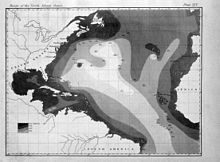 First printed map of oceanic bathymetry, published by Maury in Explanations with data from USS Dolphin (1836)
First printed map of oceanic bathymetry, published by Maury in Explanations with data from USS Dolphin (1836)
- On the Navigation of Cape Horn; by M.F.Maury, Passed Midshipman, U.S.Navy
- Whaling Charts
- Wind and Current Charts
- Sailing Directions
- [4] U.S.Navy Contributions to Science and Commerce (1847)
- Explanations and Sailing Directions to Accompany the Wind and Current Charts, 1851, 1854, 1855
- Lieut. Maury’s Investigations of the Winds and Currents of the Sea, 1851
- On the Probable Relation between Magnetism and the Circulation of the Atmosphere, 1851
- Maury’s Wind and Current Charts: Gales in the Atlantic, 1857
- [5] The Physical Geography of the Sea, 1855, 1856, 1859
- Observations to Determine the Solar Parallax, 1856
- Amazon, and the Atlantic Slopes of South America, 1853
- Commander M. F. Maury on American Affairs, 1861
- The Physical Geography of the Sea and Its Meteorology, 1861
- Maury’s New Elements of Geography for Primary and Intermediate Classes
- Geography: "First Lessons"
- Elementary Geography: Designed for Primary and Intermediate Classes.
- Geography: "The World We Live In" by M. F. Maury
- Published Address of Com. M. F. Maury, before the Fair of the Agricultural & Mechanical Society.
- Geology: A Physical Survey of Virginia; Her Geographical Position, Its Commercial Advantages and National Importance, Virginia Military Institute, 1869
External links
- Works by or about Matthew Fontaine Maury at Internet Archive (scanned books original editions color illustrated)
- Matthew Fontaine Maury website with unique pages.
- Images of Maury's medals and letters. 1996 website retrieved via the Wayback Search Engine
- CBNnews VIDEO on Commander Matthew Fontaine Maury "The Father of Modern Oceanography"
- Naval Oceanographic Office—Matthew Fontaine Maury Oceanographic Library — The World's Largest Oceanographic Library.
- United States Naval Sea Cadet Corps — Matthew Fontaine Maury — Pathfinders Division.
- The Maury Project; A comprehensive national program of teacher enhancement based on studies of the physical foundations of oceanography.
- The Mariner's Museum: Matthew Fontaine Maury Society.
- Letter to President John Quincy Adams from Commander Matthew Fontaine Maury (1847) on the "National" United States Naval Observatory regarding a written description of the observatory, in detail, with other information relating thereto, including an explanation of the objects and uses of the various instruments.
- The National (Naval) Observatory and The Virginia Historical Society (May 1849)
- Biography of Matthew Fontaine Maury at U.S. Navy Historical Center.
- The Diary of Betty Herndon Maury, daughter of Matthew Fontaine Maury, 1861–1863.
- Matthew Fontaine Maury School in Richmond, Virginia, USA, 1950s. Photographer: Nina Leen. Approximately 200 TIME-LIFE photographs
- Astronomical Observations from the Naval Observatory 1845.
Categories:- 1806 births
- 1873 deaths
- American educators
- American astronomers
- American geographers
- American earth scientists
- Microscopists
- American science writers
- American scientists
- American people of Dutch descent
- American people of French descent
- American oceanographers
- People of Virginia in the American Civil War
- People from Spotsylvania County, Virginia
- Science and technology in the United States
- American non-fiction writers
- United States Navy officers
Wikimedia Foundation. 2010.

